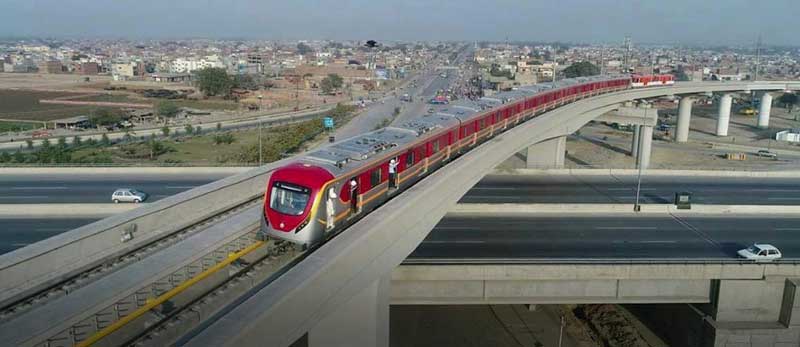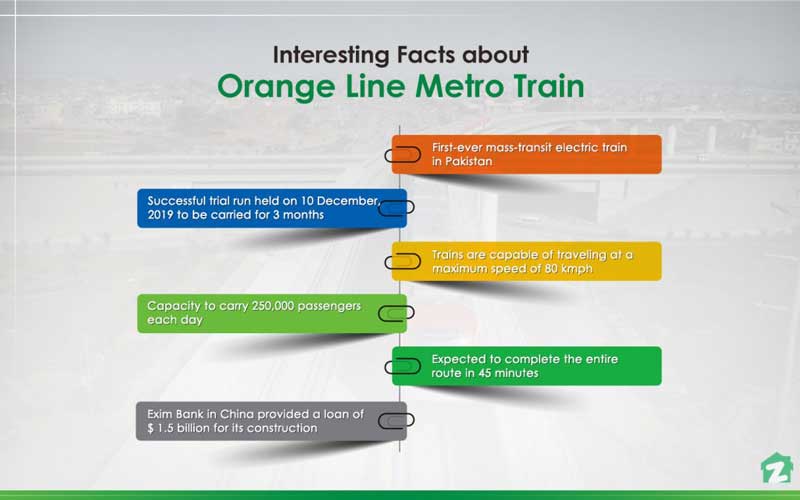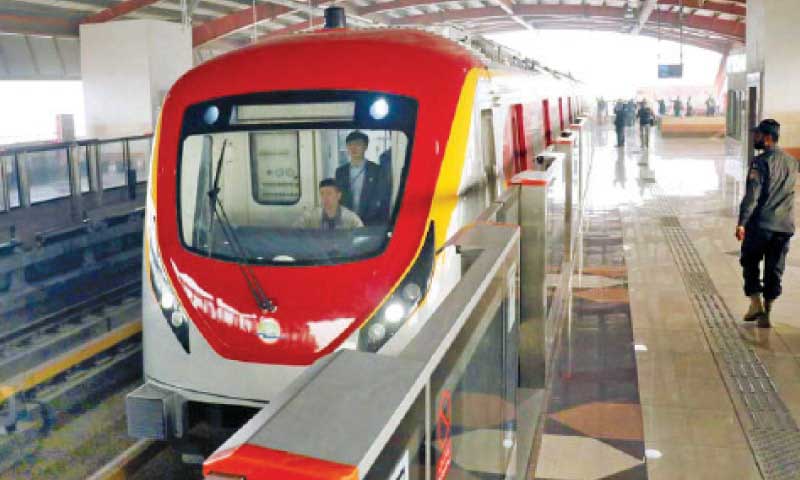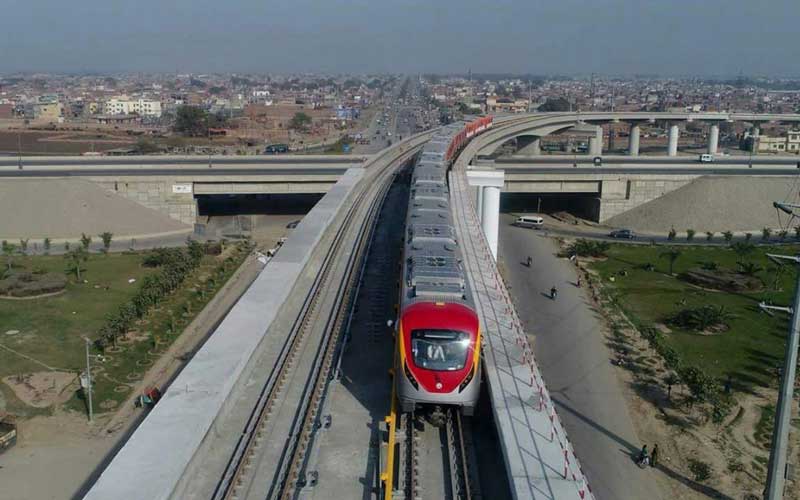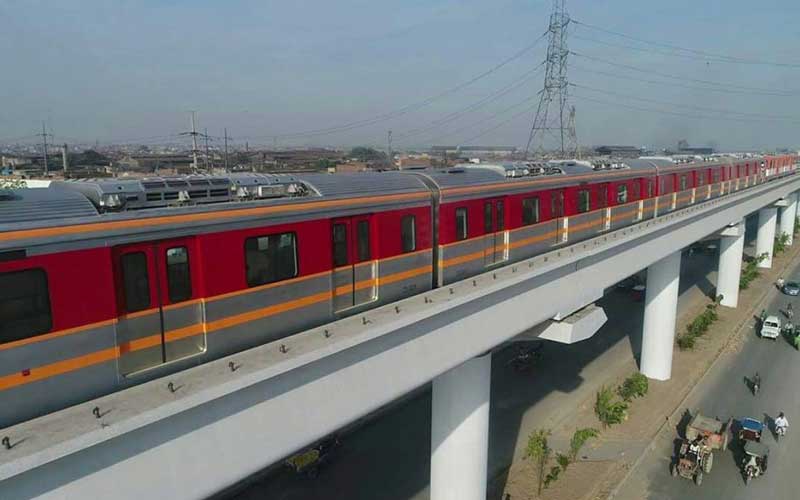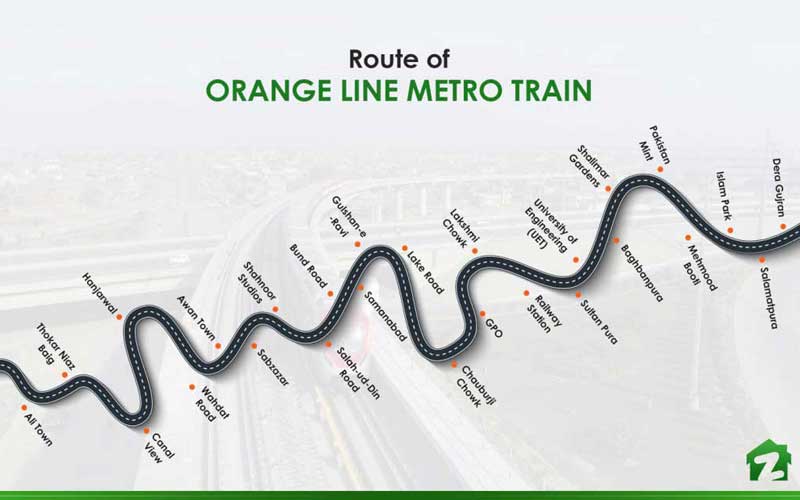OLMT: An automated rapid transit system in Lahore
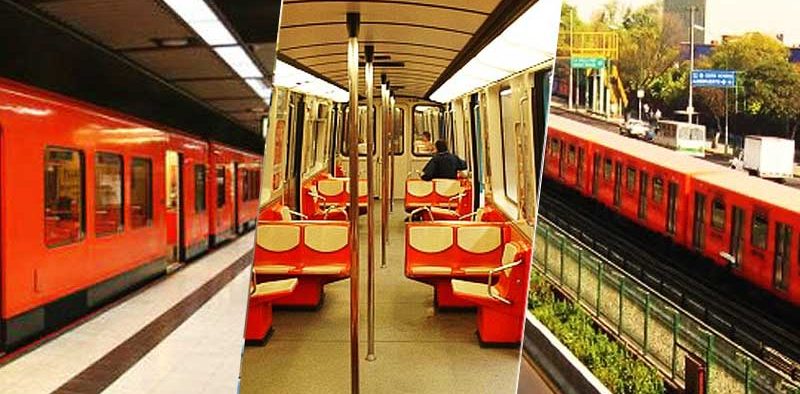
The Orange Metro Line Train (OLMT) has officially kicked off at the inaugural ceremony held on October 25, 2020, at Dera Gujran.
The OLMT is the first electricity run mass transit project with many automatic systems to facilitate the common people. The fare of OLMT is set at PKR 40 to facilitate residents. It will serve 26 stations and is expected to handle 250,000 passengers on a daily basis.
Pakistan is all set to operate its first-ever metro project in Lahore. The Orange Line Metro Train (OLMT) is part of a larger plan of introducing a mass-transit system in Pakistan to help control the increasing traffic problem and to make intracity traveling easier.
Out of the three metro lines that were proposed under the Lahore Metro master plan, the OLMT has successfully completed its test run after which it started its first journey on the 25th of October, 2020.
How will this metro train in Lahore resolve the city’s traffic problems? How will it help the environment on a broader scale? How will it improve the city’s infrastructure and outlook? What is the fare of OLMT? We will attempt to answer all of these questions in this blog as well as shed light on the features, design, and benefits of the Orange Line Metro Train in Lahore. So, keep reading to find out more about the project!
SIGNIFICANCE OF ORANGE LINE METRO TRAIN
A mass-transit system in a huge city like Lahore is essentially a necessity. Firstly, because such densely populated cities are almost always facing traffic problems. To address and control traffic jams and to help the city achieve a smooth traffic flow, a mass transit system is the need of the hour. This is why the Orange Line Metro Train holds great significance.
Anyone taking a rickshaw or a bus will now easily be able to commute via the OLMT. The addition of this mode of transport will also reduce the number of smoke-emitting vehicles on the road that poses an environmental threat as the increasing smog and air pollution is a major problem that Lahoris are facing these days.
INTERESTING FACTS ABOUT ORANGE LINE METRO TRAIN
Before we take a peek into the backstory of the OLMT and learn more about the project’s features and benefits, let’s take a look at some of the interesting facts about the first metro train in Pakistan that is all set to revolutionize the public transport system in Lahore.
BACKGROUND OF OLMT
The Orange Line Metro Train Project began when the government of China and Pakistan signed a memorandum of understanding back in 2014. China, Pakistan’s neighbor to the north, gave an initial grant of $1.55 billion in 2015 through the Export-Import (Exim) Bank of China. Soon in the month of October 2015 construction work for the urban metro train in Lahore began.
Initially, Habib Construction Services were given the contract for $ 150 million. In 2016, ZKB Engineers and Constructors were assigned to construct the railway line from Chauburji to the Ali Town area.
A budget of PKR 11.39 billion was spent on it. Later, CRRC Zhuzhou Locomotive, which is a Chinese company that manufactures electric trains, gave the first set of twenty-seven 5-bogie trains for the orange line metro in the year 2017.
After many trials and tests in 2018, the Orange Line Train had a successful test run in December 2019.
WHY IS THERE A NEED FOR A METRO TRAIN?
The increasing problem of air pollution in Lahore has been quite alarming lately. The air quality has gone quite low and people suffer due to smoke-emitting vehicles plying the road all day.
As the Orange Line Metro Train has launched in Lahore, people will prefer opting for the electric train for commuting purposes than taking out their vehicles every time they need to travel. Apart from the environmental benefits, the two underground stations of the OLMT are situated near historical sites that will provide easy travel to foreign tourists who visit these historical.
FEATURES OF ORANGE LINE METRO TRAIN
The following are some of the notable features of the orange line train that you should know of.
DESIGN OF ORANGE LINE STATIONS
The OLMT route will have 24 elevated and two underground stations; the former comprise Anarkali and Central stations.
The underground stations will be well-equipped with automatic systems, such as automated doors and a special air conditioning system, which will be a blessing during Lahore’s scorching summers.
DESIGN OF ORANGE LINE TRAINS
The design of the trains used in the orange line mass transit project is modern and of international standards. They will be driverless and fully automated. Each train consists of 5 bogies with 4 doors each. It will have a beautiful and elegant stainless steel body that will be lit using LED lights. Each bogie or car can easily accommodate around 200 passengers seated. Passengers can also comfortably stand through their journey by holding on to grab-handles and railing.
DESIGN OF ORANGE LINE TRACKS
As far as the length of the track for the project is concerned, it’s 25.58km. It comprises:
There are two lines, therefore, the overall length of the Orange Line track is 51.16km.
The tracks have incorporated Chinese technology, where jointless track circuits are embedded in the track, which will detect the presence or absence of a railway track. The main track can support around 60kg/meter while at the depot, where the trains are kept, can support 50 kg/meter. The track is laid on a concrete bed. The crossovers, where the train changes its direction, have been installed after every 2 and 3 stations.
ROUTE OF ORANGE LINE METRO TRAIN
The Orange Line Metro Train in Lahore has a route that touches major important areas of the city. Starting from Dera Gujjran, the metro line’s track is elevated and runs through the middle of the GT Road until it reaches the Shalimar Station.
However, near Shalimar station, it does not navigate through the middle but passes through the southern side of the GT Road so as to avoid any damage to the tall trees beautifying Shalimar Gardens. From there the track resumes its position passing through the middle touching stations of Baghbanpura, UET, Lahore junction to Lakshmi Chowk. The route changes its direction from Lakshmi Chowk where it enters the first underground station – the central station. The central station is situated at the junction of The Mall and Mc Leod Road. Lahore General Post Office and Lahore High Court are in front of the central station.
From there the track continues its underground journey and enters the other underground station called the Anarkali Station. Here the OLMT will be linked to the Lahore Metrobus through an underground walkway. It then passes through Lake Road and ends up at the elevated station – the Chauburji station.
From there, the line passes through the middle of Multan Road, where elevated stations like Samanabad, Bund Road, Gulshan-e-Ravi, and Shahnoor are located. At Sabzazar station, the line shifts from the middle of the Multan Road towards its eastern side. After Awan Road station, the track shifts back to the middle of Multan Road. The remaining 5.2 km journey traverses through Hanjarwala, Canal View, Thokar Niaz Beg culminating its journey at Ali Town.
HOW WILL THE TRAIN OPERATE?
The train is expected to carry around 30,000 passengers per hour, which means around 250,000 passengers will benefit daily from the service.
Supply of electricity to help run OLMT
Approximately 75 MW of electricity is required to power the trains and stations. Moreover, alternate electricity solutions are also being provided to keep the system rolling. It is expected that the electricity to run the orange line metro train project will be provided from 8 grid stations. At the moment, the UET grid station and 3 stations from the Shahnoor grid are the only electricity suppliers.
Operating hours of OLMT
As the Metro Train in Lahore is operational, its timings start from 5:30 AM to 11:30 PM, roughly covering 18 hours per day.
Maximum speed
The speed of a train determines its efficiency and efficacy. The Orange Line Train has a maximum speed of 80 km/h. Compared to the time required to travel between Dera Gujran to Ali Town, which takes around an hour, it takes 45 minutes as OLMT is operational.
ALL YOU NEED TO KNOW ABOUT THE TEST RUN
The test run of the Orange Line Train was carried out for a period of 3 months before it is officially launched and is open to the public. The test run of the Orange Line Metro Train had kicked off on December 10, 2019. During the testing phase, 5 bogies were attached to the main engine that covered a distance of 25 km in approximately 35 minutes. The test run was initiated from Dera Gujran all the way to the Ali Town neighborhood.
WHEN WILL OLMT BE FUNCTIONAL?
The Orange Line is fully functional now as it has completed its trial phase, it was expected that it will be officially launched in March 2020. However, before that, Punjab Transport Secretary Asad Rehman Gilani stated the project’s alignment, brakes, and signaling needed to be tested.
OLMT is completely functional, Lahoris get to experience the first-ever urban mass-transit train that helps ease out traffic problems in the city and make commuting easier for the residents.
FARE OF OLMT
The Punjab government bear Rs130 per trip per passenger cost to run the Orange Line Metro Train (OLMT) as it has fixed Rs40 per trip fare of the long-delayed CPEC project started by PML-N.
However, the government fixed the fare of Rs40 per passenger per trip for the six month period and reviewed to increase its stage-wise. It is likely that after six months the government will not only increase the round trip fare but also introduce zone-wise fare according to passengers’ footfall in the busiest areas of the route.
WHY OLMT PROJECT WAS DELAYED?
The project was delayed due to many reasons. But one of the reasons which were quoted by different ministers in various media briefings was that the government was working to launch the project at minimum cost by various marketing options, including establishing shops for the private sectors at the OLMT stations. Further, fare on zone-basis was under consideration. However, after wasting substantial more than one year of time on these delays, the government is finally launching the project on 25 October. The Punjab government will bear Rs130 per trip per passenger cost to run the Orange Line Metro Train (OLMT) as it has fixed Rs40 per trip fare of the long-delayed CPEC project started by PML-N.
So, this was all there was to know about the first metro train in Pakistan.
In case you want to know more about what’s going on in Pakistan and at the Global level, then head over to our detailed blogs and news on all there is to know about Beauty, Business, Celebrity, Culture, Education, Entertainment, Fashion, Food, Health, International affairs, Lifestyle, Politics, Psychology, Sports and much more. To stay abreast of the latest news regarding similar projects, stay tuned to Rangeinn Pakistan.


